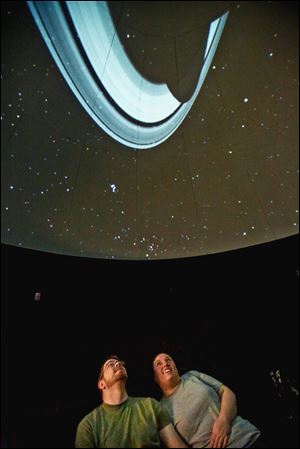
Appold Planetarium illuminates guests on sky’s wonders
Modern eyes blocked by lights
9/16/2013
Chris McAnall and Sarah Sobel-Poage, both of Perrysburg, view a projection of the rings of Saturn on the dome of the Appold Planetarium at Lourdes University in Sylvania.
In 1889 Vincent van Gogh painted The Starry Night, a depiction of the star-filled sky that he viewed from his window at the sanitarium in France.
If he looked out a window today, would he have been able to view the stars through the lights on the ground whose haze fills the sky?
Inside the Appold Planetarium at Lourdes University, Laura Megeath, planetarium coordinator, flashes an image of the United States as seen from space, across the dome-shaped screen on the theater’s ceiling. It is covered with bright spots, concentrated in the East.
“This gives you a sense of the light pollution problem,” Ms. Megeath said. “It’s preventable. People need to think about how lights are designed.”
Ms. Megeath said that without the lights, people could view the star-filled sky and the Milky Way, the galaxy Earth is part of.
“You should be able to see it from everywhere on Earth,” she said, as she showed the band of the galaxy.
Ms. Megeath, who holds a doctorate in neurobiology from the University of Massachusetts, brings stars to life on the 24-foot screen.
Different views and angles show visitors galaxies “that are too many to count,” black holes, and star activities that take place millions of light years away.
Ms. Megeath said people equate black holes to a getaway in science fiction movies. But she showed what it probably looks like in reality. The view slowly scanned across the black hole.
“If we were really able to go that fast, how fast would it be?” asked Chris McAnall, 31, of Perrysburg, who was at the planetarium with his girlfriend, Sarah Sobel-Poage, 33.
“Blazing fast,” Ms. Megeath said.
She displayed images from the National Aeronautics and Space Administration’s SOHO space telescope that showed the sun in its blazing glory. Then she showed the solar flares.
“This is amazing,” Ms. Sobel-Poage said.
Beyond the “amazing” images, the planetarium shows the value of astronomy in everyday life.
“GPS, cell phones, that’s astronomy,” Dr. Megeath said. “We use the stars for telling time. We are totally linked to the stars.”
Moreover, lessons are learned from planets. She showed Venus, a “blazingly” hot planet with clouds “miles thick.” It has an extreme greenhouse effect, which scientists can study to understand what could happen on Earth, she said.
The Appold Planetarium, 6832 Convent Blvd., is open to the public and can seat 50. It is also available for educational events, and screens films during the evening. For a complete listing of showtimes and educational movies, click here.